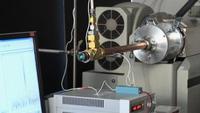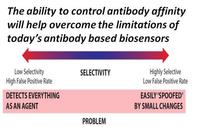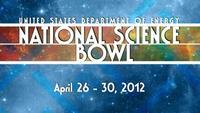-
Battle-tested technologies no employed by the police
Technologies employed in the wars in Iraq and Afghanistan are now hitting local streets across the United States, changing how local law enforcement investigates crimes by focusing on where crimes are most likely to happen instead of where a crime has taken place.
-
-
Scientists warn of sequestration’s impact on basic research
With less than a week left before sequestration is to take effect, America’s research community has repeated its call for an end to the across-the-board cuts to discretionary spending which will restrict the U.S. ability to invest in the basic scientific research. A coalition of American research and education institutions says that it is this basic research which drives innovation and produces economic growth.
-
-
Climate change as a national security issue
In a new report, Harvard researcher is pointing toward a new reason to worry about the effects of climate change — national security. During the next decade, the report concludes, climate change could have wide-reaching effects on everything from food, water, and energy supplies to critical infrastructure and economic security. “The imminent increase in extreme events will affect water availability, energy use, food distribution, and critical infrastructure — all elements of both domestic and international security,” the report’s author says.
-
-
New explosives vapor detection technology

Novel explosives detection method focuses on direct, real-time vapor detection rather than collection of explosives particles. It could change paradigm for explosives screening.
-
-
Self-healing protective coating for concrete
Scientists are reporting development of what they describe as the first self-healing protective coating for cracks in concrete, the world’s most widely used building material. The coating is inexpensive and environmentally friendly.
-
-
U.S. responds to China’s cyberattacks with anti-theft trade strategy
The Obama administration yesterday (Wednesday) unveiled the details of a broad strategy to counter the systemic theft by Chinese government agencies of U.S. trade and technology and trade secrets. The administration’s plan calls for new diplomatic push to discourage intellectual property theft abroad and better coordination at home to help U.S. companies protect themselves.
-
-
Chinese set to buy yet another U.S. taxpayer-backed hi-tech firm
Lawmakers yesterday expressed their concerns about the likelihood that U.S. taxpayer dollars could end up bolstering the Chinese economy. The lawmakers reacted to reports that a Chinese firm, Zhejiang Geely Holding Group, is leading the list of companies bidding for a majority stake in government-backed Fisker Automotive, and that the only serious rival of that Chinese company is a Chinese auto maker. Fisker’s main battery supplier — U.S. government-backed A123 Systems – has already been acquired by a separate Chinese firm.
-
-
Improving detection of, responses to biological warfare

Biological warfare agents pose more than a hypothetical threat to U.S. soldiers. Troops operate in hostile areas where they could come under attack from adversaries wielding bio-agents like anthrax and toxins. The first step in reacting to any such attack is knowing that it occurred. Quickly and accurately identifying the presence of airborne antigens can be difficult given their complexity, the presence of numerous similar microorganisms in the environment, and the fact that even minute quantities of a threat agent can cause infection. Researches seek to advance sensitivity and durability of antibody-based biosensors better to protect soldiers.
-
-
Earthquake catastrophes and fatalities to rise in 21st century
Predicted population increases in this century can be expected to translate into more people dying from earthquakes. There will be more individual earthquakes with very large death tolls as well as more people dying during earthquakes than ever before, according to a new study.
-
-
High school students to compete in DOE National Science Bowl

The U.S. Department of Energy (DOE) created the National Science Bowl in 1991 to encourage students to excel in math and science and pursue careers in related fields. More than 200,000 students have participated in the National Science Bowl in the twenty-three years since its inception. Students from Los Alamos High School will represent New Mexico at the Department of Energy’s National Science Bowl in April.
-
-
Water managers can now consult new U.S. water evaporation maps
The amount of water available for people and ecosystems is the amount of annual precipitation — that is, snow or rain — minus the amount of annual evapotranspiration. Evapotranspiration itself is the amount of water lost to the atmosphere from the ground surface. Scientists map the long-term U.S. evapotranspiration rates for the first time.
-
-
Prof. strips, stabs stuffed animal to teach quantum mechanics
Students who showed up for Monday’s quantum physics class of Professor Emlyn Hughes, a Columbia University physics professor, found out they were in for a new approach to teaching the week’s topic.
As the students entered the classroom, they were greeted with the tune of Lil Wayne’s “Drop It Like It’s Hot.” As the students were taking their seats, Hughes removed his clothes, then changed into a black T-shirt and pants. He then sat down and hugged his knees in a fetal position before airing video footage of the 9/11 2001 terror attacks, and videos of aerial bombardments from the Second World War.
-
-
Diatribes, rants in “Comments” section tarnish allure of science online
More and more digital publications, including science publications, have added a “Comments” feature to their Web sites, allowing readers to post their comments on the articles they read. This democratization of commentary, however, has been accompanied by increasingly nasty back-and-forth exchanges among readers, especially on sites where the comments are not moderated. A new study shows that in the realm of online science news, this steady diet of diatribes, screeds, and rants is taking a toll on the public perception of science and technology.
-
-
Harvard president issues a clarion call for science
Harvard President Drew Faust, addressingthe annual meeting of the American Association for the Advancement of Science (AAAS), called for members of the scientific community to “raise our voices” in an effort to prevent the U.S. Congress from becoming “an American Association for the Retreat of Science.” Urging widespread efforts to prevent U.S. cuts in funds for sustained research, Faust said: “We must secure the federal research support critical to the future of our nation and of the world.”
-
-
The sobering reality of water security
Agriculture is one of the world’s most insatiable consumers of water. Yet, it is facing growing competition for water from cities, industry, and recreation at a time when demand for food is rising, and water is expected to become increasingly scarce.
-
More headlines
The long view
Autonomous Vehicle Technology Vulnerable to Road Object Spoofing and Vanishing Attacks
Researchers have demonstrated the potentially hazardous vulnerabilities associated with the technology called LiDAR, or Light Detection and Ranging, many autonomous vehicles use to navigate streets, roads and highways. The researchers have shown how to use lasers to fool LiDAR into “seeing” objects that are not present and missing those that are – deficiencies that can cause unwarranted and unsafe braking or collisions.
Tantalizing Method to Study Cyberdeterrence
Tantalus is unlike most war games because it is experimental instead of experiential — the immersive game differs by overlapping scientific rigor and quantitative assessment methods with the experimental sciences, and experimental war gaming provides insightful data for real-world cyberattacks.
Prototype Self-Service Screening System Unveiled
TSA and DHS S&T unveiled a prototype checkpoint technology, the self-service screening system, at Harry Reid International Airport (LAS) in Las Vegas, NV. The aim is to provide a near self-sufficient passenger screening process while enabling passengers to directly receive on-person alarm information and allow for the passenger self-resolution of those alarms.
Falling Space Debris: How High Is the Risk I'll Get Hit?
An International Space Station battery fell back to Earth and, luckily, splashed down harmlessly in the Atlantic. Should we have worried? Space debris reenters our atmosphere every week.
Testing Cutting-Edge Counter-Drone Technology
Drones have many positive applications, bad actors can use them for nefarious purposes. Two recent field demonstrations brought government, academia, and industry together to evaluate innovative counter-unmanned aircraft systems.
Strengthening the Grid’s ‘Backbone’ with Hydropower
Argonne-led studies investigate how hydropower could help add more clean energy to the grid, how it generates value as grids add more renewable energy, and how liner technology can improve hydropower efficiency.
